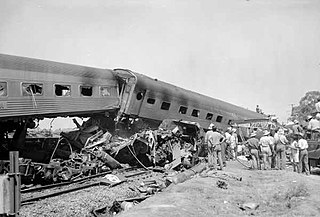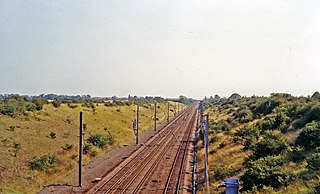
The Quintinshill rail disaster was a multi-train rail crash which occurred on 22 May 1915 outside the Quintinshill signal box near Gretna Green in Dumfriesshire, Scotland. It resulted in the deaths of over 200 people and remains the worst rail disaster in British history.

The Abergele rail disaster took place near Abergele, North Wales, in August 1868. At the time, it was the worst railway disaster to have occurred in Great Britain.

The Violet Town rail accident, also known as the Southern Aurora disaster, was a railway accident that occurred on 7 February 1969 following the incapacitation of the driver of one of the trains, near the McDiarmids Road crossing, approximately 1 km south of Violet Town, Victoria, Australia. The crash resulted in nine deaths and 117 injuries.
The Geurie crossing loop collision occurred on the night of 23 August 1963. Geurie is located between Orange and Dubbo in New South Wales, Australia.

The Charfield railway disaster was a fatal train crash which occurred on 13 October 1928 in the village of Charfield in the English county of Gloucestershire. The London, Midland and Scottish Railway (LMS) Leeds to Bristol night mail train failed to stop at the signals protecting the down refuge siding at Charfield railway station. The weather was misty, but there was not a sufficiently thick fog for the signalman at Charfield to employ fog signalmen. A freight train was in the process of being shunted from the down main line to the siding, and another train of empty goods wagons was passing through the station from the Bristol (up) direction.

The Harrow and Wealdstone rail crash was a three-train collision at Harrow and Wealdstone station in Wealdstone, Middlesex during the morning rush hour of 8 October 1952. The crash resulted in 112 deaths and 340 injuries, 88 of these being detained in hospital. It remains the worst peacetime rail crash in British history and the second deadliest overall after the Quintinshill rail disaster of 1915.

Weston-super-Mare railway station serves the seaside town of Weston-super-Mare in North Somerset, England. It is situated on a loop off the main Bristol to Taunton Line, 137 miles 33 chains from the zero point at London Paddington via Box.

Torquay railway station is on the Riviera Line and serves the seaside resort of Torquay, Devon, England. It is 219 miles 79 chains (354 km) from London Paddington.

The Abbots Ripton rail disaster occurred on 21 January 1876 at Abbots Ripton, then in the county of Huntingdonshire, England, on the Great Northern Railway main line, previously thought to be exemplary for railway safety. In the accident, the Special Scotch Express train from Edinburgh to London was involved in a collision, during a blizzard, with a coal train. An express travelling in the other direction then ran into the wreckage. The initial accident was caused by:
The Murulla rail accident involved the collision of the Sydney-bound Northern Mail with runaway goods wagons near Murrurundi, in the Upper Hunter Valley on 13 September 1926; 26 persons died. A goods train had become divided and the attempts of the train crew to reunite the portions resulted in 12 vehicles running away down a steep gradient, and colliding with the approaching mail train. This was the worst accident on the New South Wales rail network until the Granville railway disaster in 1977.
There have been a number of train accidents on the railway network of Victoria, Australia. Some of these are listed below.
The railways of New South Wales, Australia have had many incidents and accidents since their formation in 1831. There are close to 1000 names associated with rail-related deaths in NSW on the walls of the Australian Railway Monument in Werris Creek. Those killed were all employees of various NSW railways. The details below include deaths of employees and the general public.
The accident at St Bedes Junction was one of several serious accidents in 1915. It featured a double collision and fire fuelled by gas, characteristics shared by a much worse accident that year at Quintinshill. There were also similarities in that a signalman was unaware of the presence of a train near his signal box and rules were not observed. The accident is sometimes referred to as the Jarrow railway disaster as there was no station at Bede and Jarrow was then the nearest place of importance.
The Kirtlebridge rail crash took place in 1872 at Kirtlebridge railway station in Dumfriesshire. An express passenger train ran into a goods train that was shunting; 11 people lost their lives immediately, and one further person succumbed later. The cause was a failure to communicate between the station master in charge of the shunting operation, and the signalman. There was not full interlocking of the points, and the block system of signalling was not in use.
There have been a number of train accidents on the South Australian railway network. The first known incident in this list occurred in 1873 in Smithfield.
This is a list of significant railway accidents in Queensland, Australia.

Copmanthorpe railway station served the village of Copmanthorpe, North Yorkshire, England from 1839 to 1959 on the York to Normanton line. The line also became part of the East Coast Main Line at various periods. The station was moved and substantially rebuilt halfway through its working life.









